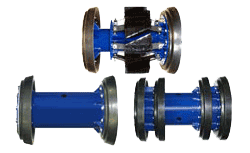

The History of the Corporation |
|---|
The brush manufacturing business which ultimately became Pilley Industries originated prior to 1889 in St. Louis, Missouri under the name of the American Manufacturing Company owned by Mr. L.B. Shultz. On the 22nd day of July 1889, the Shultz-Miller Manufacturing Company was incorporated under the laws of the State of Missouri and was authorized to purchase the business then being conducted by L.B. Shultz. Mr. E.M. Miller was elected President of the new company. On May 21, 1890, Mr. E.M. Miller tendered his resignation and Mr. C.A. Pilley was elected President. On July 29, 1890, the name of the corporation was changed to the St. Louis Steel Wire Brush Company. Mr. C.A. Pilley continued as President. On January 25, 1900, the corporate name of the company was again changed to the Pilley Packing and Flue Brush Manufacturing Company. On April 4, 1908, Mr. L.B. Shultz was elected President of the corporation, filling the vacancy caused by the death of Mr. C.A. Pilley. On June 20, 1927, C.F. Shultz was elected President due to the death of L.B. Shultz. On June 30, 1939, the company name was changed again to the Pilley Brush Company. In early 1940, during the modernization of the St. Louis riverfront and the establishment of the Jefferson Memorial, the manufacturing facility of the Pilley Brush Company became a part of the program and it became necessary for them to relocate. A suitable building was found in Ft. Madison, Iowa which was purchased and the entire facility was moved to Ft. Madison. The Missouri corporation was dissolved and the company was incorporated in the State of Iowa on May 29, 1941. On Monday May 9, 1966, the old brick building housing Pilley Brush Company was destroyed by a fire. Crandon Paper Mill, who owned the old Sinclair buildings allowed Pilley Brush to temporarily relocate within the Sinclair building until Pilley could construct the new building. The new building was constructed on the same location as the old building. By January 1967, Pilley Brush moved into the new building and the name of the corporation was changed to Pilley Industries, Inc. On June 30, 1967, V.I. (Inez) Shultz was elected President due to the death of her husband, C.F. Shultz. in 1982, V.I. Shultz sold Pilley Industries to Pipeline Dehydrators, Inc. of Houston, TX. Mr. Terry VanAken was elected President. A sister company, Pipeline Cleaners Co. of Ft. Madison was formed to handle a different product line suitable to Pipeline Dehydrators, Inc. In October 1994, Pilley Industries and Pipeline Cleaners, Inc. was sold along with Pipeline Dehydrators, Inc. of Houston, TX to NOWSCO from Calgary, AB, Canada. Terry VanAken remained President of Pilley Industries and Pipeline Cleaners, Inc. Pipeline Dehydrators, Inc. of Houston was dissolved. In October 1996, BJ Services of Houston, TX did a forced takeover of NOWSCO. Pilley Industries and Pipeline Cleaners, Inc. were retained but NOWSCO was dissolved. Terry VanAken remained President of Pilley Industries and Pipeline Cleaners, Inc. By September 1, 2001, Pilley Industries and Pipeline CLeaners, Inc. were documented to be Pipeline Cleaners, Inc. and was sold to Inline Services, Inc. of Tomball, TX. Terry VanAken remained President of Pipeline Cleaners, iNc. On January 1, 2011, Pipeline Cleaners, Inc. was split off Inline Services, Inc. via a stock swap agreement. There were six owners of Inline Services, Inc. Three of those owners took full ownership of Pipelines Cleaners, Inc. Terry VanAken remained President of Pipeline Cleaners, Inc. |
| FAQ |
Pigging Information |
1. Why do they call them pigs? The pipeline cleaning tool will sometimes make a squealing sound when it travels through the pipeline. 2. How do they get the pig in the pipeline? Pipelines are designed to have launchers and receivers at various places along the pipeline. They have closures on the launchers and receivers that allow pressure to build behind the pig for launching. For receiving the pig, the pressure is released before opening the closure and pulling the pig out. 3. Why pig a pipeline? Cleaning, initial gauging, geometry or caliper pigging, hydrostatic testing, dewatering, drying, commissioning and inspection with smart pigs are some of the reasons to pig a pipeline. 4. What makes a pig go? The pig moves through the pipeline with whatever product is in the line. That product could be crude oil, natural gas, air or water. It could be any liquid or gas product. It is differential pressure that moves the product and the pig. 5. What is black powder? Black powder consists of iron compounds and iron sulphide, clay and salt. Black powder is generated during natural gas production and causes bacterial corrosion. This corrosion can cause pits on the inside of the pipeline. 6. How can you get the clack powder out of the pipeline? New pig designs using pencil brushes helps clean the pits formed on the inside of the natural gas pipeline and helps remove the black powder. |
 |
Pipeline Cleaners, Inc.1823 33rd Street PO Box 157 Fort Madison, Iowa 52627 Phone: 800.372.2051 FAX: 319.372.7091

